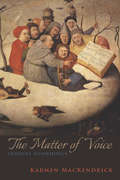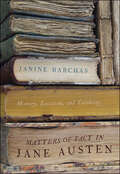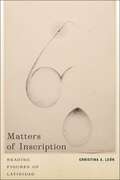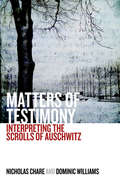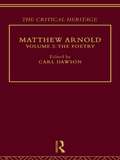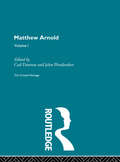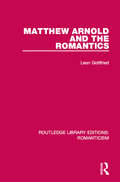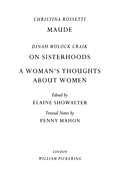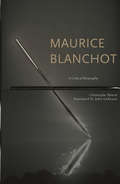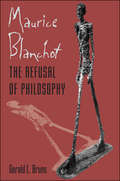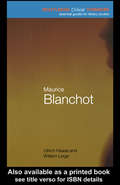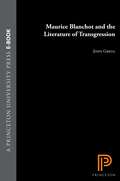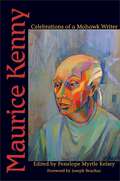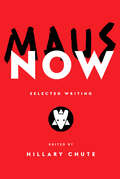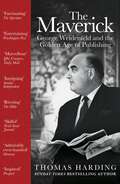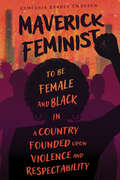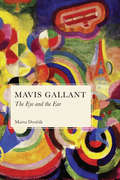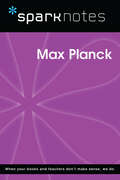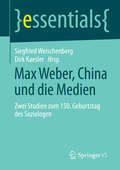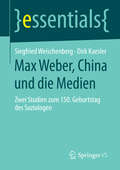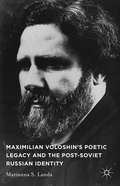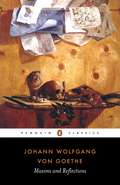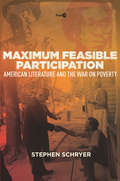- Table View
- List View
The Matter of Voice: Sensual Soundings
by Karmen MacKendrickPhilosophers for millennia have tried to silence the physical musicality of voice in favor of the purity of ideas without matter, souls without bodies. Nevertheless, voices resonate among bodies, among texts, and across denotation and sound; they are singular, as unique as fingerprints, but irreducibly collective too. They are material, somatic, and musical. But voices are also meaningful—they give body to concepts that cannot exist in abstractions, essential to sense yet in excess of it. They can be neither reduced to neurology nor silenced in abstraction. They complicate the logos of the beginning and emphasize the enfleshing of all words. Through explorations of theology and philosophy, pedagogy, translation, and semiotics, all interwoven with song, The Matter of Voice works toward reintegrating our thinking about both speaking and authorial voice as fleshy combinings of meaning and music.
Matters of Fact in Jane Austen: History, Location, and Celebrity
by Janine BarchasDiscover the links between characters in Jane Austen novels and real-life celebrities of the time.Winner of the CHOICE Outstanding Academic Title of the Choice ACRLIn Matters of Fact in Jane Austen: History, Location, and Celebrity, Janine Barchas makes the bold assertion that Jane Austen’s novels allude to actual high-profile politicians and contemporary celebrities as well as to famous historical figures and landed estates. Barchas is the first scholar to conduct extensive research into the names and locations in Austen’s fiction by taking full advantage of the explosion of archival materials now available online. According to Barchas, Austen plays confidently with the tension between truth and invention that characterizes the realist novel. Of course, the argument that Austen deployed famous names presupposes an active celebrity culture during the Regency, a phenomenon recently accepted by scholars. The names Austen plucks from history for her protagonists (Dashwood, Wentworth, Woodhouse, Tilney, Fitzwilliam, and many more) were immensely famous in her day. She seems to bank upon this familiarity for interpretive effect, often upending associations with comic intent. Barchas re-situates Austen’s work closer to the historical novels of her contemporary Sir Walter Scott and away from the domestic and biographical perspectives that until recently have dominated Austen studies. This forward-thinking and revealing investigation offers scholars and ardent fans of Jane Austen a wealth of historical facts, while shedding an interpretive light on a new aspect of the beloved writer's work.
Matters of Inscription: Reading Figures of Latinidad
by Christina A. LeónA compelling exploration of materiality and semiotics in Latinx inscriptionsWriters and artists from Cuba, Puerto Rico, and Latinx New York operate under the pressures of inscription: the material and semiotic entanglement of making a mark as a marked artist. By employing layered material tropes and figures, such as stone, dust, viscera, and animality, their works do not represent a singular Latinx experience and instead, must be read at the margin of language and matter. Matters of Inscription explores feminist and queer inscriptions of Latinidad, encompassing the intersections of materiality and semiotics in art, performance, poetry, plays, and fiction. By delving into these figural matters, Christina A. León highlights how writers and artists such as Zilia Sánchez, Ana Mendieta, Manuel Ramos Otero, María Irene Fornés, Justin Torres, and Roque Salas Rivera forge material inscriptions that transcend individual lives and call for a broader analytical perspective unmoored from biographical anchors.The book urges readers to reevaluate the notion of difference, which has momentarily sought solace in identitarian terminology. León engages in rhetorical analysis that reassesses how the terms of Latinx studies have been challenged and how they are failing. Rather than categorizing texts based on predetermined taxonomic terms or individual subjects’ lives, the book tracks figures situated at the edges of materiality and semiosis. This approach addresses the continuous marginalization and dispossession that shape the phenomenon of Latinx identity (“latinidad”) by recentering conceptual questions of origin, diaspora, pedagogy, and belonging. The book contends that losses and deprivations should be rendered incommensurate to avoid collapsing the richness of different experiences or scales of ontological debasement.By focusing on the interplay of materiality and semiotics, Matters of Inscription challenges conventional approaches that seek to homogenize and anticipate what Latinx might mean and instead calls for a more capacious and nuanced analysis that goes beyond individual biographies.
Matters of Testimony: Interpreting the Scrolls of Auschwitz
by Nicholas Chare Dominic WilliamsIn 1944, members of the Sonderkommando-the "special squads," composed almost exclusively of Jewish prisoners, who ensured the smooth operation of the gas chambers and had firsthand knowledge of the extermination process-buried on the grounds of Auschwitz-Birkenau a series of remarkable eyewitness accounts of Nazi genocide. This careful and penetrating study examines anew these "Scrolls of Auschwitz," which were gradually recovered, in damaged and fragmentary form, in the years following the camp's liberation. It painstakingly reconstructs their historical context and textual content, revealing complex literary works that resist narrow moral judgment and engage difficult questions about the limits of testimony.
Matthew A. B. C.
by Peter CatalanottoWho is missing from Mrs. Tuttle's kindergarten class? Will he fit in as well as the other 25?
Matthew Arnold: The Critical Heritage Volume 2 The Poetry (Critical Heritage Ser.)
by Carl DawsonFirst published in 1995. Routledge is an imprint of Taylor & Francis, an informa company.
Matthew Arnold: The Critical Heritage Volume 1 Prose Writings
by Carl Dawson John PfordresherFirst Published in 1995. Routledge is an imprint of Taylor & Francis, an informa company.
Matthew Arnold and the Romantics (Routledge Library Editions: Romanticism #11)
by Leon GottfriedFirst published in 1963. Matthew Arnold grew up under the personal as well as literary influence of Wordsworth, when Keats, Shelley, and Byron were dominant poetic forces and Coleridge a seminal thinker on social and religious problems. However, the great Romantics were not always positive influences. This study attempts to provide an examination of Arnold by exploring and evaluating the full range of Arnold’s reactions to the major Romantic poets over his whole career. This title will be of interest to students of literature.
Maude by Christina Rossetti, On Sisterhoods and A Woman's Thoughts About Women By Dinah Mulock Craik (Pickering Women's Classics)
by Christina Rossetti"Maude" was written when Christina Rossetti was 19 and examines the heroine's struggle to resist the notion that modesty and domesticity constitute the duties of women. "On Sisterhoods" by Dinah Mulock Craik advocates the encouragement of Anglican sisterhoods.
Maurice Blanchot: A Critical Biography
by Christophe BidentMaurice Blanchot has long inspired writers, artists, and philosophers with some of the most incisive statements of what it meant to experience the traumas and turmoils of the twentieth century. Bident’s magisterial biography provides the first full-length account of Blanchot’s itinerary, drawing on unpublished letters and interviews with the writer’s close friends, while also providing a sophisticated genealogy of his thought.A journalist and activist, but also inclined to secrecy, Blanchot lived public and private lives that converged at some of the century’s most momentous occasions: He was nearly executed during the Occupation, participated prominently in the May ’68 revolution in Paris, and, more controversially, wrote for the far right in the ’30s. Even-handed throughout, Bident offers a much-needed fleshing out of a life too easily sensationalized.
Maurice Blanchot: The Refusal of Philosophy
by Gerald L. BrunsA series of close readings addresses the philosophical and political questions that have surrounded Blanchot and his writings for decadesSelected by Choice Magazine as an Outstanding Academic TitleAs a novelist, essayist, critic, and theorist, Maurice Blanchot has earned tributes from authors as diverse as Jacques Derrida, Giles Deleuze, and Emmanuel Levinas. But their praise has told us little about what Blanchot's work actually says and why it has been so influential. In the first comprehensive study of this important French writer to appear in English, Gerald Bruns ties Blanchot's writings to each other and to the works of his contemporaries, including the poet Paul Celan.Blanchot belongs to the generation of French intellectuals who came of age during the 1930s, survived the Occupation, and flourished during the quarter century or so after World War II. He was one of the first French intellectuals to take a systematic interest in questions of language and meaning. His focus in the mid-1930s on extreme situations—death, madness, imprisonment, exile, revolution, catastrophe—anticipated the later interest of the existentialists. Like Nietzsche, Wittgenstein, and Adorno, Blanchot was a self-conscious writer of fragments, and he has given us one the most developed investigations that we have on the fragment as a kind of writing.In a series of close readings, Bruns addresses the philosophical and political questions that have surrounded Blanchot and his writings for decades. He describes what is creative in Blanchot's readings of Heidegger's controversial works and examines Blanchot's conception of poetry as an inquiry into the limits of philosophy, rationality, and power.
Maurice Blanchot: Ethics And The Ambiguity Of Writing (Routledge Critical Thinkers)
by Ullrich Haase William LargeWithout Maurice Blanchot, literary theory as we know it today would have been unthinkable. Jacques Derrida, Paul de Man, Michel Foucault, Roland Barthes, Gilles Deleuze: all are key theorists crucially influenced by Blanchot's work.This accessible guide:* works 'idea by idea' through Blanchot's writings, anchoring them in historical and intellectual contexts* examines Blanchot's understanding of literature, death, ethics and politics and the relationship between these themes* unravels even Blanchot's most complex ideas for the beginner* sketches the lasting impact of Blanchot's work on the field of critical theory.For those trying to come to grips with contemporary literary theory and modern French thought, the best advice is to start at the beginning: begin with Blanchot, and begin with this guide.
Maurice Blanchot and the Literature of Transgression
by John GreggIn this book, the first in English devoted exclusively to Maurice Blanchot, John Gregg examines the problematic interaction between the two forms of discourse, critical and fictional, that comprise this writer's hybrid oeuvre. The result is a lucid introduction to the thought of one of the most important figures on the French intellectual scene of the past half-century.Gregg organizes his discussion around the notion of transgression, which Blanchot himself took over from Georges Bataille--most palpably in his interpretation of the myth of Orpheus--as a paradigm capable of accounting for the relationships that exist in the textual economies formed by author, work, and reader. Chapters on the critical work address such issues as Blanchot's ambivalent attitude toward the speculative dialectic of Hegelianism, his thematization of literature's involvement with death, and the mythical and Biblical figures he uses to portray the acts of reading and writing. Gregg also performs extended close readings of two representative works of fiction, Le Très-Haut and L'Attente l'oubli, in an effort to trace Blanchot's evolution as a creator of narratives and to ascertain how his fiction can be seen as constituting a mise en oeuvre of the concerns he treats in his criticism. The book concludes with an assessment of Blanchot's place in the recent history of French critical theory.
Maurice Kenny: Celebrations of a Mohawk Writer
by Penelope Myrtle KelseyWinner of the 2012 Best Critical Book Award presented by Wordcraft Circle of Native Writers and Storytellers AssociationThis collection explores the broad range of works by Mohawk writer Maurice Kenny (1929–), a pivotal figure in American Indian literature from the 1950s to the present. Born in Cape Vincent, New York and the author of dozens of books of poetry, fiction, and essays, Kenny portrays the unique experience of Native New York and tells its history with poetic figures who live and breathe in the present. Perhaps his best known work is Tekonwatonti/Molly Brant: Poems of War.Kenny's works have received various accolades and awards. He was recognized by the Wordcraft Circle of Native Writers and Storytellers with the Elder Achievement Award, and two of his collections of poems, Blackrobe and Between Two Rivers, were nominated for the Pulitzer Prize. Kenny has also been honored with the American Book Award for The Mama Poems. His works have been recognized by National Public Radio, and have drawn the attention of famous figures such as Allen Ginsberg, Jerome Rothenberg, and Carolyn Forché.Maurice Kenny: Celebrations of a Mohawk Writer serves as a comprehensive introduction to Kenny's body of work for readers who may be unfamiliar with his writing. Written by prominent scholars in American Indian literature, the book is divided into two parts: the first is devoted to musings on Kenny's influence, and the second to traditional critical essays using historical, nationalist, Two Spirit, creative, memoir, and tribal-theoretical approaches.
Maus Now: Selected Writing
by Edited by Hillary ChuteRichly illustrated with images from Art Spiegelman&’s Maus (&“the most affecting and successful narrative ever done about the Holocaust&” —The Wall Street Journal), Maus Now includes work from twenty-one leading critics, authors, and academics—including Philip Pullman, Robert Storr, Ruth Franklin, and Adam Gopnik—on the radical achievement and innovation of Maus, more than forty years since the original publication of &“the first masterpiece in comic book history&” (The New Yorker).Pulitzer Prize-winning cartoonist Art Spiegelman is one of our most influential contemporary artists; it&’s hard to overstate his effect on postwar American culture. Maus shaped the fields of literature, history, and art, and has enlivened our collective sense of possibilities for expression. A timeless work in more ways than one, Maus has also often been at the center of debates, as its recent ban by the McMinn County, Tennessee, school board from the district&’s English language-arts curriculum demonstrates.Maus Now: Selected Writing collects responses to Spiegelman&’s monumental work that confirm its unique and terrain-shifting status. The writers approach Maus from a wide range of viewpoints and traditions, inspired by the material&’s complexity across four decades, from 1985 to 2018. The book is organized into three loosely chronological sections— &“Contexts,&” &“Problems of Representation,&” and &“Legacy&”—and offers for the first time translations of important French, Hebrew, and German essays on Maus.Maus is revelatory and generative in profound and long-lasting ways. With this collection, American literary scholar Hillary Chute, an expert on comics and graphic narratives, assembles the world&’s best writing on this classic work of graphic testimony.
The Maverick: George Weidenfeld and the Golden Age of Publishing
by Thomas HardingBorn into a Jewish family in Vienna in 1919, George Weidenfeld fled to England in 1938 to escape the Nazi regime. There he began a career in publishing that would make him one of the most influential figures in the industry. Over the course of his long and illustrious career he championed some of the most important voices of the twentieth century, from Vladimir Nabokov, Mary McCarthy and Saul Bellow to Harold Wilson, Isaiah Berlin and Henry Kissinger.But what do we know about the man himself? Was he, as described by some, the 'greatest salesperson', 'the world's best networker', 'the publisher's publisher' and 'a great intellectual'? Was his lifelong effort to be the world's most famous host a cover for his desperate loneliness? Who, in fact, was the real George Weidenfeld and how did he rise so successfully within the ranks of London and New York society? Providing a full, unvarnished and at times difficult history of this complex man, this first biography of a titan of culture is also a story of resilience, determination and the power of ideas to shape history.
Maverick Feminist: To Be Female and Black in a Country Founded upon Violence and Respectability
by Kemeshia Randle SwansonBeginning with their forced introduction to American soil, Black women have relied on maverick-like characteristics to survive. And yet, these liberating qualities have been repeatedly disparaged by the masses in favor of an elitist politics of respectability. In Maverick Feminist: To Be Female and Black in a Country Founded upon Violence and Respectability, scholar Kemeshia Randle Swanson examines the extent to which the politics of respectability diminish joy and increase sorrow throughout the lifespan of Black women. By rejecting this damaging standard in society, Black women can wholly and attentively assist in the obliteration of racist, sexist, classist, and ableist oppression. But first, they must work towards becoming self-identified, self-actualized, and self-sexualized.Bridging the gap between women in both the streets and the academy, Maverick Feminist expands the traditional understandings of activism and enlarges discussions about Black female sexuality. Swanson emphasizes sexuality’s significance to the literary and sociopolitical success of Black women of the past and in this contemporary climate. Through close readings and critical analyses of fiction, nonfiction, and popular culture, Swanson argues that #BlackGirlMagic and racial progression require rejecting respectability politics and developing an intimate appreciation of self. Maverick Feminist examines texts by and about bold Black women, including Zora Neale Hurston’s Their Eyes Were Watching God, Sister Souljah’s The Coldest Winter Ever, Brittney Cooper’s Eloquent Rage: A Black Feminist Discovers Her Superpower, Alice Walker’s The Color Purple, Sapphire’s PUSH, Roxane Gay’s Hunger: A Memoir of (My) Body, Terry McMillan’s Getting to Happy, and Michelle Obama’s Becoming.Maverick Feminist offers hope concerning the growing divide between scholars and the communities about which they theorize. The book celebrates centuries of agency and control that Black women have mustered and maintained in a world that seems to want nothing more than to see them prone and powerless. Ultimately, maverick feminism provides a freer means of living out, evaluating, understanding, and improving the lives of Black women.
Mavis Gallant: The Eye and the Ear
by Marta DvorakDrawing on private correspondence and conversations with the Gallant she repositions as a late modernist, Marta Dvořák investigates the connections between the Paris-based master of the short story and visual and sound culture. Through the filter of philosophical aesthetics, she identifies the painterly, cinematic, and musical dynamics which light up Gallant’s craft. At the same time, she opens a dialogue between Gallant and other international modernists, and with those they were reading, watching, and listening to, from the moving pictures which shaped Gallant’s generation to the rhythm and dissonance of, say, Stravinsky and jazz, which - like the Cubist rupture with spatial perspective — spearheaded modernity’s aesthetics of breakage. How does Gallant’s work work? Dvořák’s hands-on rhetorical analyses of Gallant’s stories and lesser-known, recently reissued novels illuminate the superb stylist’s language and vision via an emphasis on both image and rhythm. Providing keys to Gallant’s famous sleights-of-hand and tonal shifts, the discussions reveal a fictional world as multidimensional as a Cubist picture or a symphony - depending on whether we lean towards the eye or the ear.
Max Planck (SparkNotes Biography Guide)
by SparkNotesMax Planck (SparkNotes Biography Guide) Making the reading experience fun! SparkNotes Biography Guides examine the lives of historical luminaries, from Alexander the Great to Virginia Woolf. Each biography guide includes:An examination of the historical context in which the person lived A summary of the person&’s life and achievements A glossary of important terms, people, and events An in-depth look at the key epochs in the person&’s career Study questions and essay topics A review test Suggestions for further reading Whether you&’re a student of history or just a student cramming for a history exam, SparkNotes Biography guides are a reliable, thorough, and readable resource.
Max Weber, China und die Medien: Zwei Studien zum 150. Geburtstag des Soziologen (essentials)
by Siegfried Weischenberg and Dirk KaeslerIn der ersten Studie werden Max Webers Anregungen für eine Mediensoziologie im Rahmen von allgemeinen Überlegungen zur Wissenschaftsforschung untersucht. Im Zentrum steht dabei die These, dass in einschlägigen Studien grundsätzlich die Bibliographie von Wissenschaftlern Vorrang haben sollte vor biographischen Details. In der zweiten Studie werden Max Webers Untersuchungen der zwei großen religiösen Ordnungen des traditionellen China, des Konfuzianismus und Taoismus behandelt. Vor Webers innerem Auge stand ein riesiges Kaiserreich, in dem die „Literaten“ die herrschende Schicht stellten, in dem literarische Bildung Maßstab sozialen Prestiges war und in dem diese führende Intellektuellenschicht der entscheidende Träger der Kultur gewesen sein soll und deswegen in einer besonders intimen Beziehung zum Kaiser stand. Der Inhalt Biografie, Bibliografie und Bibliometrie: Wissenschaftsforschung am Beispiel von Max Webers Mediensoziologie.- Der Traum von der Herrschaft der Literaten: Max Weber über China Die ZielgruppenDozierende und Studierende der Medien- und Kommunikationswissenschaft. Die Autoren Dr. Siegfried Weischenberg ist seit mehr als drei Jahrzehnten als Professor an Universitäten im In- und Ausland tätig; er hat zahlreiche große empirische Studien zum Journalismus durchgeführt. Dr. Dirk Kaesler ist Professor für Allgemeine Soziologie an der Philipps-Universität Marburg. Er gehört zu den führenden Weber-Forschern.
Max Weber, China und die Medien: Zwei Studien zum 150. Geburtstag des Soziologen (essentials)
by Siegfried Weischenberg Dirk KaeslerIn der ersten Studie werden Max Webers Anregungen für eine Mediensoziologie im Rahmen von allgemeinen Überlegungen zur Wissenschaftsforschung untersucht. Im Zentrum steht dabei die These, dass in einschlägigen Studien grundsätzlich die Bibliographie von Wissenschaftlern Vorrang haben sollte vor biographischen Details. In der zweiten Studie werden Max Webers Untersuchungen der zwei großen religiösen Ordnungen des traditionellen China, des Konfuzianismus und Taoismus behandelt. Vor Webers innerem Auge stand ein riesiges Kaiserreich, in dem die „Literaten“ die herrschende Schicht stellten, in dem literarische Bildung Maßstab sozialen Prestiges war und in dem diese führende Intellektuellenschicht der entscheidende Träger der Kultur gewesen sein soll und deswegen in einer besonders intimen Beziehung zum Kaiser stand.
Maximalism in Contemporary American Literature: The Uses of Detail (Routledge Studies in Contemporary Literature)
by Nick LeveyThis book begins a new and foundational discussion of maximalism by investigating how the treatment of detail in contemporary literature impels readers to navigate, tolerate, and enrich the cultural landscape of postindustrial America. It studies the maximalist novels of David Foster Wallace, Nicholson Baker, Thomas Pynchon, and others, considering how overly-detailed writing serves the institutional, emotional, and intellectual needs of contemporary readers and writers. The book argues that maximalist novels not only exceed perceived limits of style, subject matter, and scope, but strive to remake the usefulness of books in contemporary culture, refreshing the act of reading. Levey shows that while these novels are preoccupied with detail and description, they are relatively unconcerned with the traditional goals of representation. Instead, they use detail to communicate particular values and fantasies of intelligence, enthusiasm, and ability attached to the management of complex and excessive information. Whether reinvigorating the banal and trivial in mainstream culture, or soothing anxieties of human insufficiency in the age of automation and the internet, these texts model significant abilities, rather than just objects of significance, and encourage readers to develop habits of reading that complement the demands of an increasingly detailed culture. Drawing upon a diverse range of theoretical schools and cultural texts, including Thing Theory, Marxism, New Formalism, playlists, blogs, and archival manuscripts, the book proposes a new understanding of maximalist writing and a new way of approaching the usefulness of literary objects in contemporary culture.
Maximilian Voloshin’s Poetic Legacy and the Post-Soviet Russian Identity
by Marianna S. LandaFamed and outspoken Russian poet, Maximilian Voloshin's notoriety has grown steadily since his slow release from Soviet censorship. For the first time, Landa showcases his vast poetic contributions, proving his words to be an overlooked solution both to the political and cultural turmoil engulfing the Soviet Union in the early twentieth century.
Maxims and Reflections
by Johann Wolfgang GoetheThroughout his long, hectic and astonishingly varied life, Johann Wolfgang von Goethe (1749–1832) would jot down his passing thoughts on theatre programmes, visiting cards, draft manuscripts and even bills … Goethe was probably the last true ‘Renaissance Man’. Although employed as a Privy Councillor at the Duke of Weimar’s court, where he helped oversee major mining, road-building and irrigation projects, he also painted, directed plays, carried out research in anatomy, botany and optics – and still found time to produce masterpieces in every literary genre. His fourteen hundred Maxims and Reflections reveal some of his deepest thought on art, ethics, literature and natural science, but also his immediate reactions to books, chance encounters or his administrative work. Although variable in quality, the vast majority have a freshness and immediacy which vividly conjure up Goethe the man. They make an ideal introduction to one of the greatest of European writers.
Maximum Feasible Participation: American Literature and the War on Poverty (Post*45)
by Stephen SchryerThis book traces American writers' contributions and responses to the War on Poverty. Its title comes from the 1964 Opportunity Act, which established a network of federally funded Community Action Agencies that encouraged "maximum feasible participation" by the poor. With this phrase, the Johnson administration provided its imprimatur for an emerging model of professionalism that sought to eradicate boundaries between professionals and their clients—a model that appealed to writers, especially African Americans and Chicanos/as associated with the cultural nationalisms gaining traction in the inner cities. These writers privileged artistic process over product, rejecting conventions that separated writers from their audiences. "Participatory professionalism," however, drew on a social scientific conception of poverty that proved to be the paradigm's undoing: the culture of poverty thesis popularized by Oscar Lewis, Michael Harrington, and Daniel Moynihan. For writers and policy experts associated with the War on Poverty, this thesis described the cultural gap that they hoped to close. Instead, it eventually led to the dismantling of the welfare state. Ranging from the 1950s to the present, the book explores how writers like Jack Kerouac, Amiri Baraka, Gwendolyn Brooks, Oscar Zeta Acosta, Alice Walker, Philip Roth, and others exposed the War on Poverty's contradictions during its heyday and kept its legacy alive in the decades that followed.
